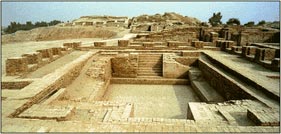

 |  |
Town Planning: The excavations of the ruins showed a remarkable skill in town planning. The main streets and roads were set in a line, sometimes running straight for a mile, and were varying in width from 4 meters to 10 meters. Most of these roads and streets were paved with fire brunt bricks. On the either side of the street stood houses of various sizes which did not protrude into the streets. The main streets intersected at right angles, dividing the city into squares or rectangular blocks each of which was divided length wise and cross wise by lanes. Some buildings had a lamp post and a well. There was an elaborate drainage system which emptied into the river. The Drainage System; The Drainage System of the Indus Valley Civilization was far advanced. The drains were covered with slabs. Water flowed from houses into the street drains. The street drains had manholes at regular intervals. Housewives were expected to use pits in which heavier part of the rubbish will settle down while only sewerage water was allowed to drain off. All soak pits and drains were occasionally cleaned by workmen. In every house there was a well-constructed sink, and water flowed from the sink into the underground sewers in the streets. This elaborate drainage system shows that the Indus Valley people were fully conversant with the principles of health and sanitation. Houses: The houses were of different sizes varying from a palatial building to one with two small rooms. The houses had a well, a bathroom, and a covered drain connected to the drain in the street. The buildings were made of burnt bricks, which have been preserved even to this day. Sun-dried bricks were used for the foundation of the buildings and the roofs were flat and made of wood. The special feature of the houses was that rooms were built around an open courtyard. Some houses were double storied. Some buildings had pillared halls; some of them measured 24 square meters. It is assumed that there also must have been palaces, temples or municipal halls.  Great Bath: One of the largest buildings was the Great Bath measuring 180 feet by 108 feet. The bathing pool, 39 feet long, 28 feet wide and 8 feet deep was in the center of the quadrangle, surrounded with verandahs, rooms and galleries. A flight of steps led to the pool. The pool could be filled and emptied by means of a vaulted culvert, 6 feet and 6 inches high. The walls of the pool were made of burnt bricks laid on edge, which made the pool watertight. The pool was filled with water from a large well, situated in the same complex. Periodic cleaning of the pool was done by draining off the used water into a big drain. The Great Bath building had six entrances. The Great Bath reflected the engineering genius of those ancient days.
Great Bath: One of the largest buildings was the Great Bath measuring 180 feet by 108 feet. The bathing pool, 39 feet long, 28 feet wide and 8 feet deep was in the center of the quadrangle, surrounded with verandahs, rooms and galleries. A flight of steps led to the pool. The pool could be filled and emptied by means of a vaulted culvert, 6 feet and 6 inches high. The walls of the pool were made of burnt bricks laid on edge, which made the pool watertight. The pool was filled with water from a large well, situated in the same complex. Periodic cleaning of the pool was done by draining off the used water into a big drain. The Great Bath building had six entrances. The Great Bath reflected the engineering genius of those ancient days.Great Granary: Another large building in the city was the Great Granary which was made about 45 meters long and 15 meters wide. It was meant to store food grains. It had lines of circular brick platforms for pounding grain. There were barrack like quarters for workmen. The granary also had smaller halls and corridors. The Assembly Hall: An important feature of Mohen-jo-daro was its 24 square meters pillared hall. It had five rows of pillars, with four pillars in each row. Kiln baked bricks were used to construct these pillars. Probably, it was the Assembly Hall or the ruler's court. It is said that it also housed the municipal office which had the charge of town planning and sanitation. next page >> |
Copyright ©2000 indiansaga.info. All rights reserved.
By using this service, you accept that you won't copy or use the data given in this website for any commercial purpose.
The material on indiansaga.info is for informational & educational purpose only.
This site is best viewed at 800 X 600 picture resolution.